Harmonic Drive Telescope Mounts are disrupting the astronomy and astrophotography world.
Previously, German Equatorial Mounts were the obvious choice for astrophotographers, with Alt-Azimuth mounts dominant for astronomy.
But the Harmonic Drive Mount is becoming increasingly popular, with more models entering the market and prices coming down. They are small, light, accurate, and require no counterweights.
So is it time to switch to a Harmonic Drive Mount or are there some downsides?
In this article, we are going to explain all you need to know and help you decide if they are right for you.
What is a Harmonic Drive?
A Harmonic Drive – also known as a Strain Wave Drive – is a form of mechanical drive that is used in a number of engineering applications, including robotics and automobiles.
They are capable of a high ratio of payload capacity to the weight of the equipment and are extremely precise.
We will focus in this article on the application in telescope mounts, but if you want to understand more about how strain wave drives work then you can watch this video:
What Are Harmonic Drive Telescope Mounts?
Harmonic Drive Telescope mounts are, not surprisingly, telescope mounts that incorporate harmonic drives.
Although harmonic drives have been around for a long time, it is only in recent years that astronomy equipment manufacturers have started producing telescope mounts that incorporate them.
The appeal here for astronomy and, in particular, astrophotography is that you can have a smaller, lighter mount that is capable of reliably carrying the OTA (telescope) with precise tracking and no counterweights.
Harmonic Drive Mounts Pros and Cons
We’ll dig now into what the positives and potential downsides are.
Harmonic Drive Mount Advantages
The advantages of harmonic drive mounts are:
- Weight: The big selling point of harmonic drive mounts is that they are small and light, especially in comparison to German Equatorial Mounts (GEMs). This makes them easier to use, store and transport. For example, the mount head for the Sky-Watcher EQ6-R Pro German Equatorial Mount weighs 38 lbs (17 kg) whereas the head for the ZWO AM5 Harmonic Drive Mount weighs just 11 lbs (5 kg).
- Ease of setup: Further to the lighter mount head, harmonic drives do not need counterweights (although they can optionally added to increase the payload capacity). This makes them much quicker and easier to set up with no need to balance as you would with a GEM.
- High accuracy: Harmonic mounts are capable of a high degree of tracking accuracy and are free from the periodic errors and backlash that are inherent in GEMs. This means that they do not need to utilize guiding as you may do with a GEM to improve its performance. Another simplification of the setup and process.
Harmonic Drive Mount Disadvantages
The disadvantages of harmonic mounts are:
- Price: Although prices have been coming down, harmonic Drive Mounts are more expensive than German Equatorial Mounts with similar capacity levels.
- Lower payload capacity: Related to price, a harmonic mount with the same payload capacity as a GEM will cost much more. For example, for around $2000 you could get a Sky-Watcher EQ6-R Pro with a capacity of 44 lbs (20 kg), or a ZWO AM5 with a capacity of 29 lbs (13 kg). However, if you add counterweights to the ZWO AM5 it can also take 44 lbs (20 kg), therefore you can trade off that smaller size/ease of use for an increased capacity.
- Lack of proven performance: Although the theory about performance is great, there is much less proof of performance in comparison to GEMs that have been around for a long time and are well-tested (see the data here on the best astrophotography mounts, for example). This is the result of them being new, but it is still a valid challenge given that some mounts for Sky-Watcher, Celestron, Astro-Physics and others are so well-proven over the years.
Best Harmonic Drive Telescope Mounts
At the time of writing, I found 18 currently available harmonic drive mounts on sale.
I have listed them here by price of cheapest to most expensive, as well as including whether they are alt-azimuth (AZ), equatorial (EQ), or hybrid (AZ/EQ):
| Mount | Price | Type |
|---|---|---|
| ZWO AM3 | $1,499 | AZ/EQ |
| iOptron HEM27 | $1,888 | EQ |
| iOptron HAE29 | $1,998 | AZ/EQ |
| ZWO AM5 | $1,999 | AZ/EQ |
| iOptron HAZ31 | $2,098 | AZ |
| iOptron HEM44 | $2,698 | EQ |
| iOptron HAE43 | $2,798 | AZ/EQ |
| iOptron HAZ46 | $2,898 | AZ |
| Pegasus Astro NYX-101 | $2,960 | AZ/EQ |
| Sharpstar Mark III | $3,398 | AZ/EQ |
| Hobym Crux 140 Traveller | $3,590 | EQ |
| Rainbow Astro RST-135 | $3,895 | AZ/EQ |
| Rainbow Astro RST-135E | $5,495 | AZ/EQ |
| Hobym Crux 170HD | $5,930 | EQ |
| Rainbow Astro RST300 | $8,490 | AZ/EQ |
| Hobym Crux 200HDA | $8,554 | EQ |
| Hobym Crux 320HDA | $12,000 | EQ |
| Hobym Crux T4000 | $24,433 | EQ |
Price
The prices are all from either the manufacturer’s site or from an astronomy retailer and were correct at the time of writing, but will vary.
With some of the mounts there are some variations that can change the price.
For instance, the iOptron models can be bought with optional in-built iPolar to help with polar alignment, and/or encoders to improve tracking accuracy, others also have the option to include a tripod. All of these things will alter the price.
The ZWO AM3 is the cheapest harmonic mount. It was newly released in April 2023.
Weight
You can see in the chart below that there is a fair bit of variation between the lightest harmonic mounts and the heaviest ones.
The lightest and most portable harmonic mounts all weigh between 7 lbs and 8 lbs. These are the:
- Rainbow Astro RST-135
- Hobym Crux 140 Traveller
- Rainbow Astro RST-135E
- iOptron HEM27
- iOptron HAE29
- iOptron HAZ31
However, quite a few other models weigh just a few pounds more and so there are a lot of lightweight options for good portability:
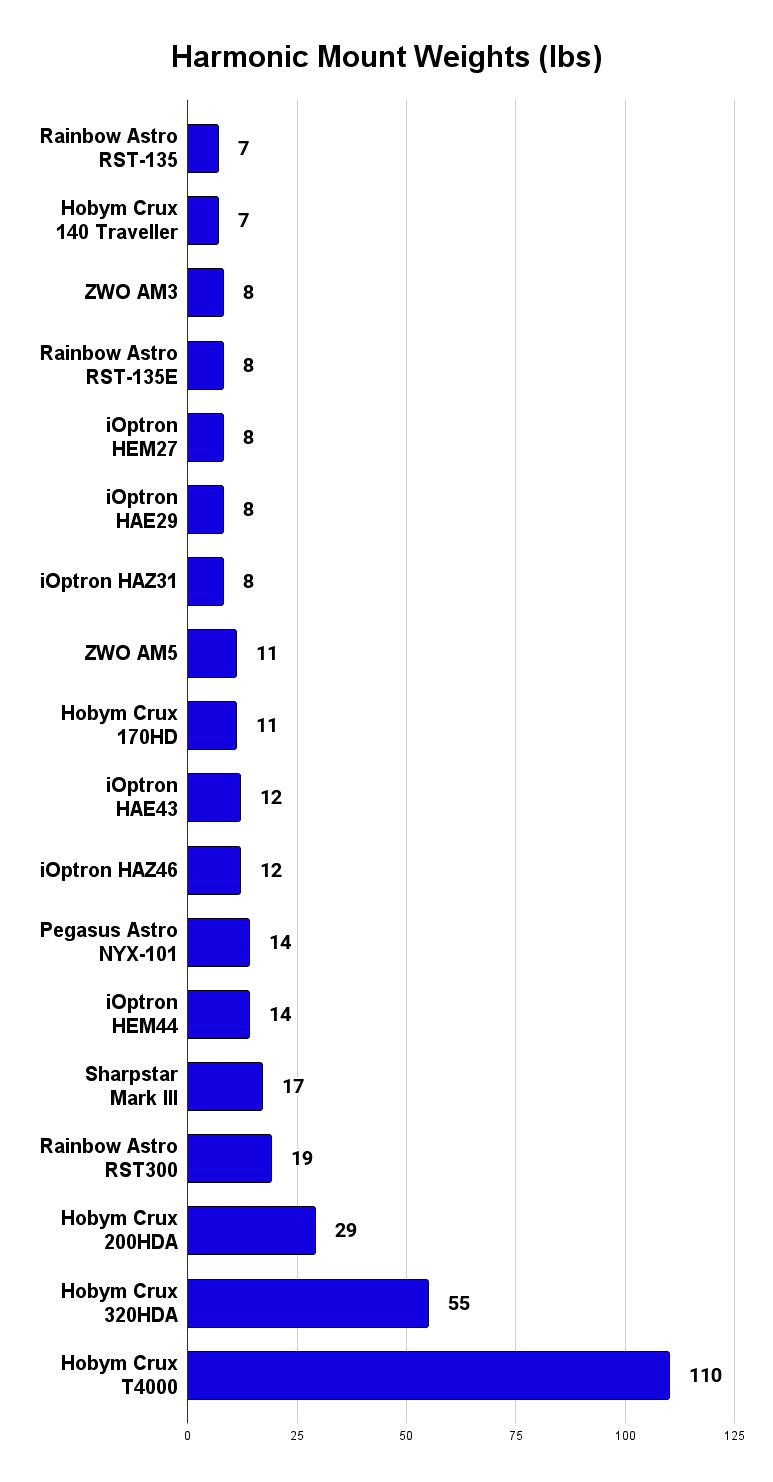
Payload capacity
With regards to payload capacity, some of the lighter models have a fairly low limit and so you need to make sure that your OTA and accessories will not exceed this.
We’ve put the weight and payload capacity of all these mounts together in this chart:
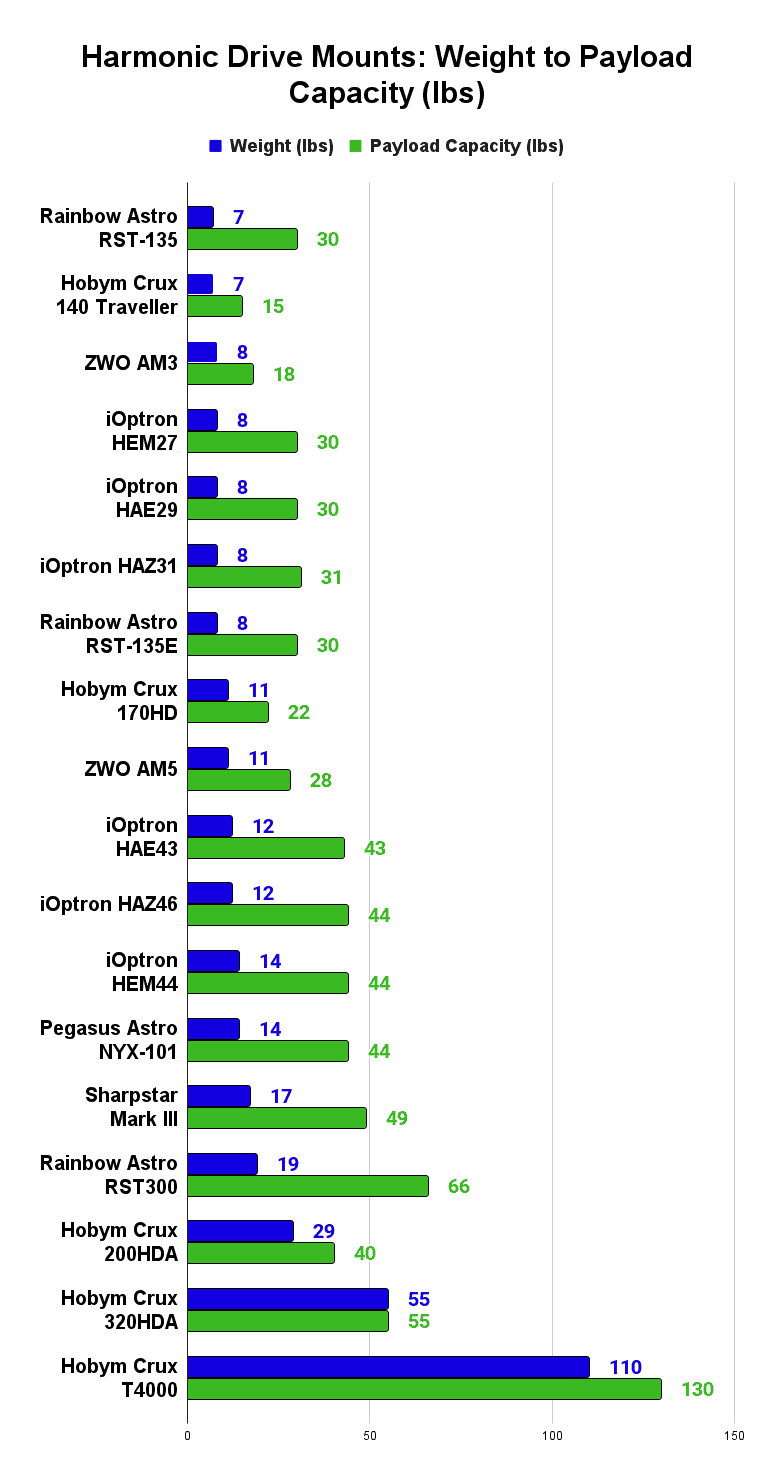
However, some of these mounts also have the option to add counterweights to increase the payload capacity.
You can see here the increased payload capacity of these mounts when adding counterweights (the iOptron models do not have this capacity so are not listed):
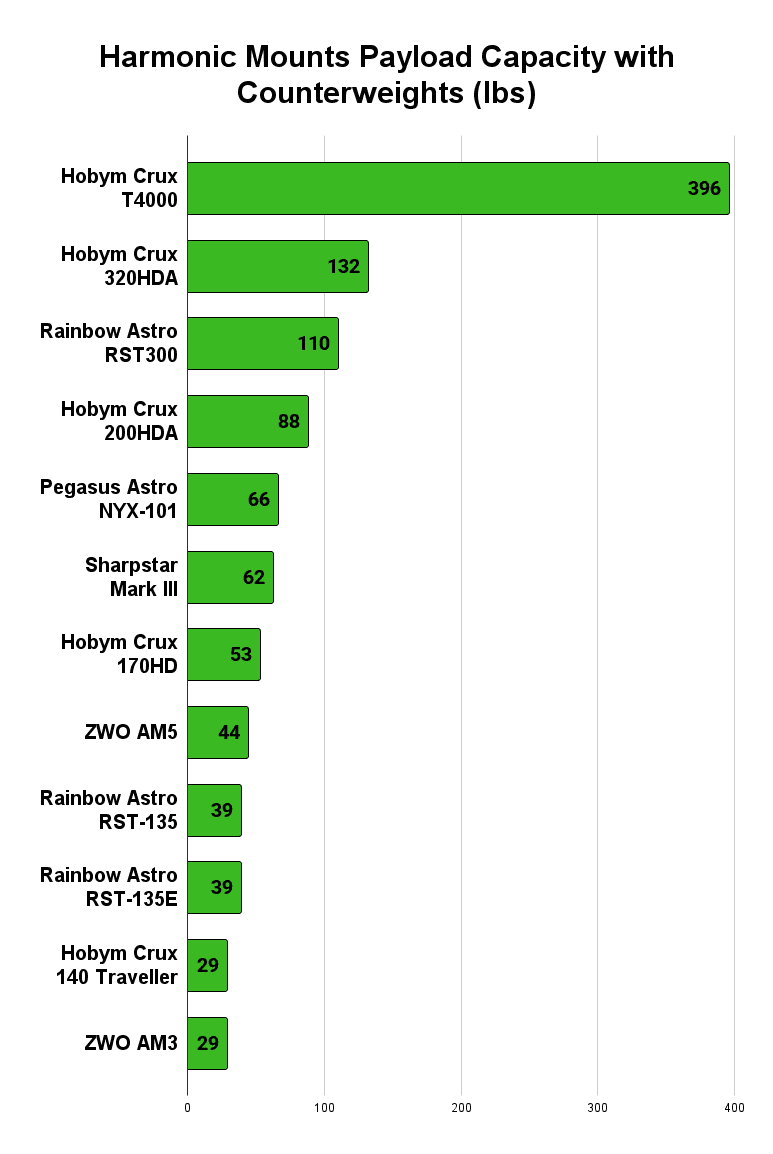
Obviously, this negates one of the advantages of harmonic mounts – that you don’t need counterweights – but having the option if your setup grows can only be a good thing.
For more information on any of these mounts, check out the manufacturer’s sites here:
Harmonic Drive Mounts for Astrophotography
Harmonic Drive Mounts are particularly appealing for astrophotography given the need for tracking accuracy for long periods, as well as the quicker setup and portability.
At Skies & Scopes, we do an annual review of the equipment used in the images shortlisted for the Astronomy Photographer of the Year competition and have examined nearly 700 photos in total for the last five years.
When looking at the types of mounts that are used, German Equatorial Mounts are by far the most successfully used, as you can see in this chart:
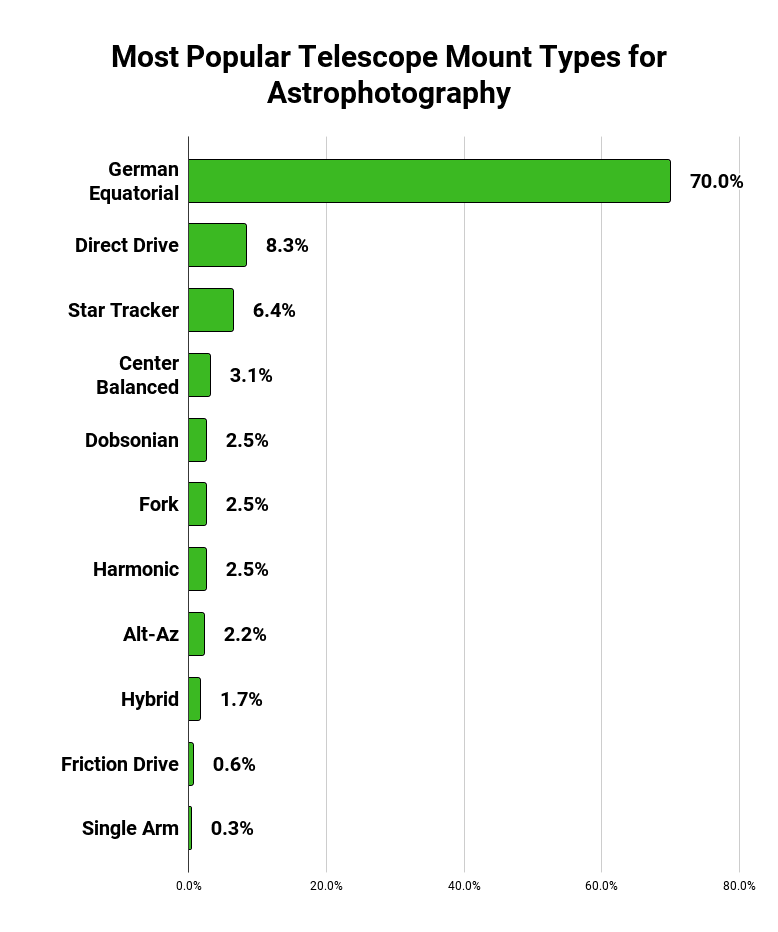
Only a very small percentage of images have used harmonic mounts so far, but this has to take into account their relative newness and is not necessarily a verdict on their capacity.
The harmonic mount models used in the data above are the Rainbow Astro RST-135 and the Hobym Crux 140 Traveller.
It will be interesting to see if in future years whether more astrophotographers start moving over to harmonic mounts from GEMs.
You can see all the most successfully used mount models in our article on the Best Mounts for Astrophotography.
Let’s look now at what different harmonic mount models are available.
DIY Harmonic Drive Mounts
If you don’t want to spend the money you could have a go at building your own harmonic mount, as detailed in this video.
It is not an easy process for someone without an engineering background and the right facilities – the author/creator Alan (Jialiang) Zhao is a PhD student at MIT – but it makes for a great watch and he shares all the details for others to have a go:
Verdict: Should You Buy a Harmonic Drive Mount?
The Harmonic vs German Equatorial mount debate/decision feels to me similar to the shift from DSLRs to mirrorless cameras which has gradually taken place over the past few years.
Many photographers and astrophotographers will have trusty DSLRs that they know and trust and will stick with, but when it comes to buying a new model it is more likely that they will now go for a mirrorless as the price has come down.
The same with mounts, few will just ditch a trusted GEM if it has worked well for them but if buying new then they would likely be tempted by a harmonic mount as the reduced size and weight make them so appealing.
The question then just really comes down to price and capacity. You will know the weight of your OTA and what you need, but how much is it going to cost with a harmonic mount versus a german equatorial?
Related Articles:


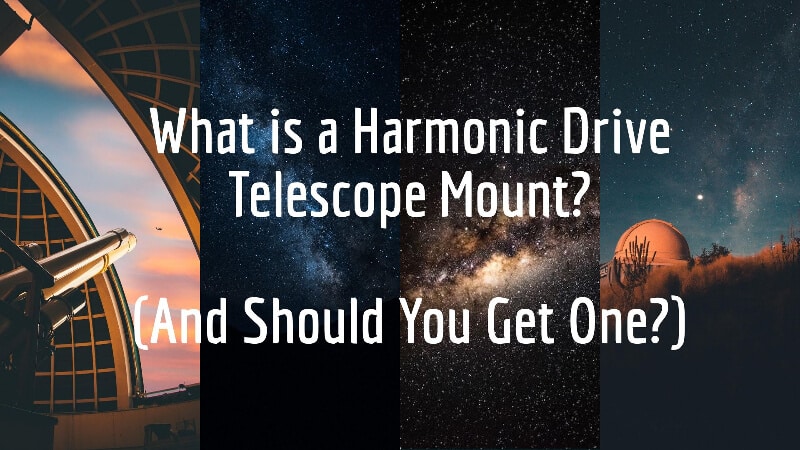

Im confused…you state that the cost is higher per gem mount and price
zwo am5 = max capacity 44lb with counterweight (its actually only for safety as the tripod is a carbon fiber very light tripod, hence it could fall over with a longer heavier telescope if not used with a counterweight)
eqr6 pro max is 44lb…..however its commonly known to go around half of that as the max payload claim for this level of gem is exagerrated. if you put 44lb on an eq6r your tracking would be all over the place.
both mounts are AROUND $2000 …and theIve realistic capacity is higher on the am5 (Ive had 39lb on my am5 and tracked with 0.7 arc/sec with poor seeing)
and of course harmonic = ZERO backlash…..which is impossible on an eqr6 pro.
am5 also has absolute encoders
Hi Rich, thanks for sharing your experience.
Are you saying that the ZWO AM5 is the same price and the same payload capacity as the Sky-Watcher EQ6 R-Pro, but in your opinion the AM5 is the better mount?
I take your point about this, in general though I think it is fair to say “Although prices have been coming down, harmonic Drive Mounts are more expensive than German Equatorial Mounts with similar capacity levels.”
Many thanks
Anthony
This info listed in the “pro” section is wrong:
“High accuracy: Harmonic mounts are capable of a high degree of tracking accuracy and are free from the periodic errors and backlash that are inherent in GEMs. This means that they do not need to utilize guiding as you may do with a GEM to improve its performance.”
Strainwave drives have a high degree of periodic error and do require guiding. ZWO sends periodic error test results with each mount because of this.
Thanks Mike, good info.